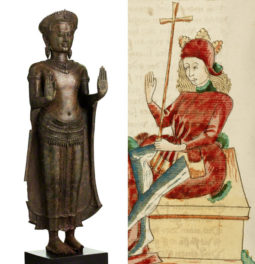
Watching you? Inlaid eyes on a Chiurazzi bronze bust of a young woman in the Atrium of the Getty Villa
Accompanying you as you wander the gardens at the Getty Villa are 44 beings in bronze—animals, gods, satyrs, troubled philosophers, athletic youths crouched for action, wild-eyed old men with scraggly beards.
These are replicas of ancient Roman sculptures commissioned by J. Paul Getty in the 197os from the Chiurazzi foundry in Naples, Italy, one of the few firms in possession of direct casts from classical treasures in the Naples Museum. (More on the foundry’s history in an earlier post here.)
The bronzes at the Villa are copies of sculptures unearthed in the mid-1700s at the ancient Roman Villa dei Papiri in Herculaneum, the primary model for the Villa’s architecture and gardens.
The owner of this opulent seaside estate displayed them not only to spark conversation among the wealthy guests who strolled his grounds, but also to underscore his intellectual pedigree. A number of the statues, for example, depict Greek philosophers and rulers; so the collection was, historian and author Carol Mattusch told me, “a way to show what a great Philhellene he was, and how he wanted to emulate the way the classical Greeks lived.” (Nonetheless, he did sneak a few portraits of Romans into this collection of Greek gods, rulers, and thinkers—family members, most likely.)
For J. Paul Getty, always keen to identify with esteemed collectors of the past, the modern replicas played a similar role.
The statues at the Getty Villa mirror the display at the Villa dei Papyri in their placement as well as their form. Museum curators and conservators consulted Karl Weber’s 18th-century excavation plan, which lays out the location of each sculpture—from the drunken Satyr to the angst-ridden “Pseudo Seneca”—and arranged many of the replicas in locations paralleling their original findspots. The bronzes that inspired the replicas can be seen 1,400 miles away in the National Archaeological Museum in Naples, Italy.
Other than their history, the most compelling thing about the Chiurazzi bronzes at the Villa has to be their wonderfully expressive (and sometimes eerie) eyes, as Carol describes here. Made of inlaid stone and glass like their Roman models, they seem to track you as you pass by, asking you to stop for a moment and appreciate them.




you forgot my favorite one:
http://www.flickr.com/photos/sfphotocraft/2231570657/
That IS a great one (perhaps, the very weirdest one of all!). How could I have forgotten good old “Silenos Riding a Wineskin,” who presides over the koi pond in the Herb Garden. I just added him to the Flickr set…although I only have a demure side view, not head-on, like yours. Nice work!